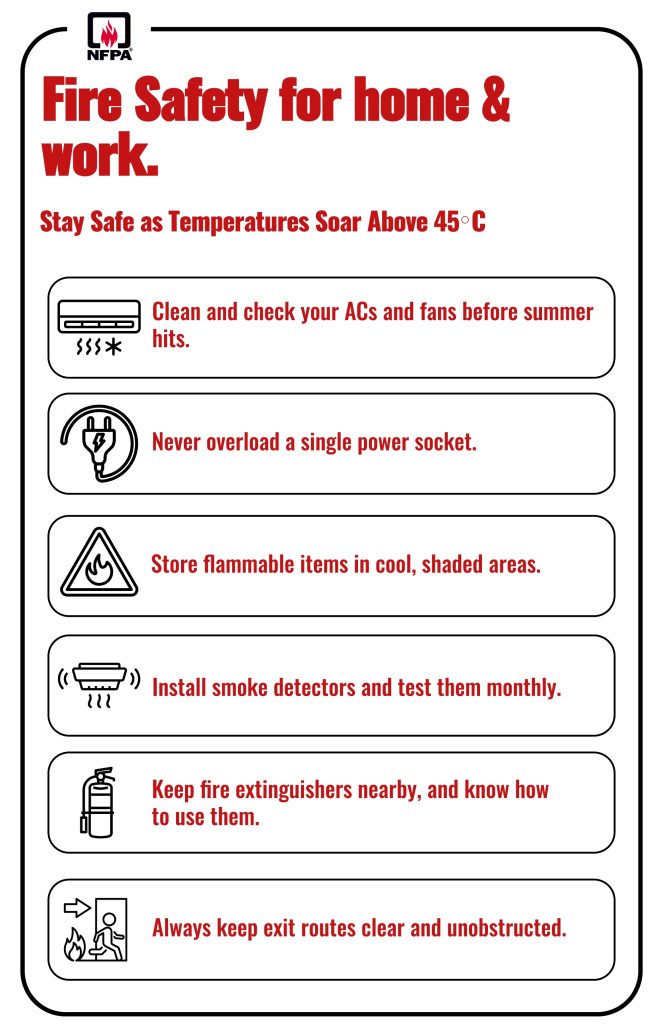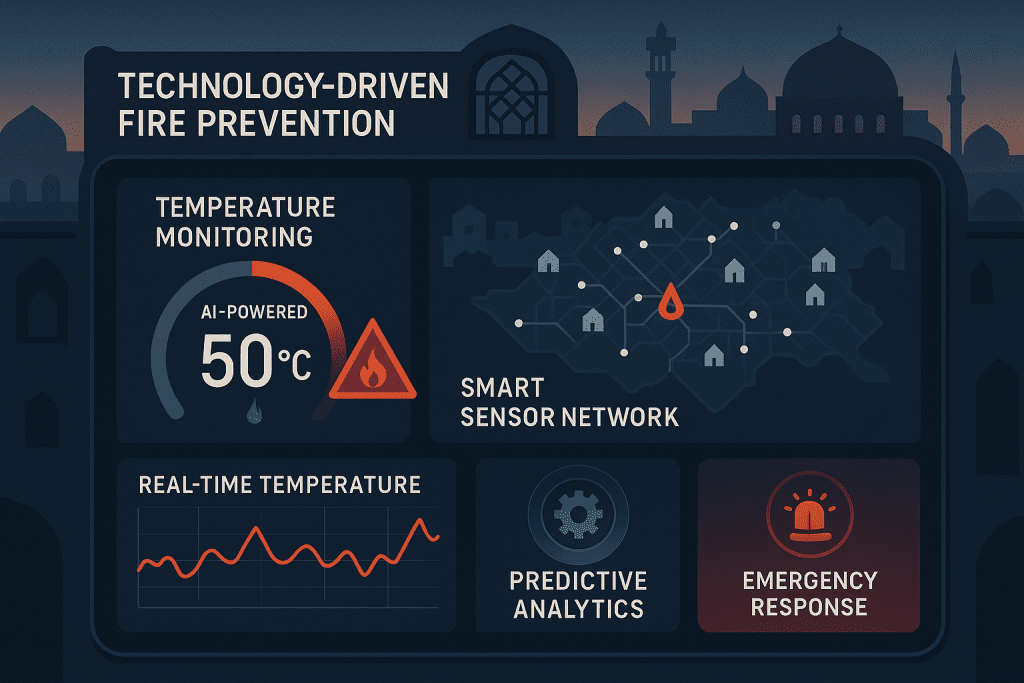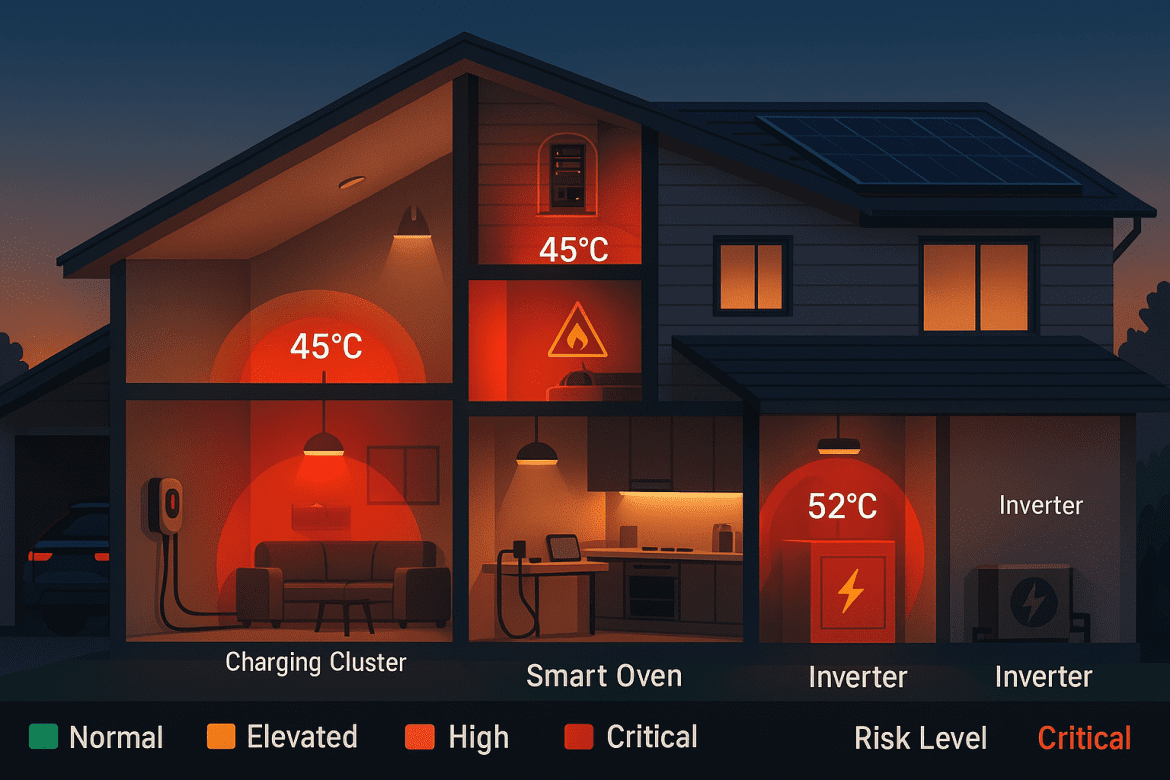The Hidden Danger: Why Your Smart Home Might Be Your Biggest Fire Risk
Last week, a Tesla Model S caught fire in a Dubai parking garage. Not from an accident—from the heat alone. The lithium-ion battery, pushed beyond its thermal limits by the relentless Gulf sun, entered what experts call “thermal runaway.” Excessive heat creates internal instability, resulting in thermal runaway that can turn your cutting-edge technology into a dangerous liability in seconds.
This isn’t an isolated incident. UAE authorities are warning drivers to avoid storing six specific items in vehicles: pressurized containers, batteries and power banks, hand sanitizers, perfumes, gas cylinders and lighters—everyday items that become explosive when exposed to extreme heat.
If you think this is just about cars, think again. Your smart home, filled with IoT devices, charging stations, and connected appliances, faces the same thermal challenges that are reshaping fire safety protocols across the GCC.
The Science Behind Summer Fire Explosions: What Nobody Tells You
The Physics of Heat-Induced Ignition
When temperatures soar above 45°C—a regular occurrence across the GCC—the molecular behavior of everyday materials fundamentally changes. Here’s what happens:
Battery Chemistry Breakdown: Modern devices rely on lithium-ion batteries designed for optimal performance between 16°C and 35°C. Beyond 60°C (easily reached inside vehicles or poorly ventilated rooms), the electrolyte begins to decompose, generating gases that can ignite explosively.
Pressure Vessel Failures: That innocent hand sanitizer bottle in your car becomes a potential bomb. Alcohol-based solutions expand rapidly under heat, creating pressure that can rupture containers and create flash fire scenarios.
Electrical System Overload: Air conditioning systems working overtime don’t just consume more electricity—they generate heat that can compromise electrical connections, leading to arc faults and electrical fires.
Real-World Case Studies That Will Change How You Think
Case Study 1: The Dubai Office Building Incident In July 2024, a prestigious Dubai office building experienced a fire that started in the IT server room. The root cause? Inadequate cooling during a weekend when the building’s HVAC system was running on reduced capacity. The servers, designed to operate below 27°C, overheated when ambient temperatures reached 35°C inside the building.
Lesson: Smart temperature monitoring could have prevented this AED 2.3 million loss.
Case Study 2: The Sharjah EV Charging Station An electric vehicle charging overnight in a residential garage experienced thermal runaway at 3 AM when garage temperatures exceeded 42°C. The fire spread to two adjacent vehicles before emergency services arrived.
Lesson: Extinguishing fires in electric vehicles may be more difficult than fighting a fire in conventional combustion-engine cars, making prevention absolutely critical.
Revolutionary Prevention: The AI-Powered Fire Safety Ecosystem
Smart Detection: Beyond Traditional Smoke Alarms
The future of fire safety isn’t reactive—it’s predictive. The integration of AI and IoT into fire safety systems marks a significant advancement, with AI revolutionizing fire alarm systems by enabling them to predict potential fire hazards through environmental data analysis.
Next-Generation Detection Systems Include:
- Thermal Imaging Networks: AI-powered cameras that detect temperature anomalies before ignition
- Gas Sensors: IoT devices that identify combustible gas buildups
- Predictive Analytics: Machine learning algorithms that analyze usage patterns to predict equipment failures
- Environmental Monitoring: Real-time tracking of humidity, temperature, and air quality

The Smart Home Integration Revolution
The Smart Home Integration Revolution
Homeowners can now install IoT-enabled solutions that automatically trigger when high temperatures or smoke are detected, integrating seamlessly with smart home networks including alarms and security cameras.
Practical Implementation Examples:
Smart Cooling Management: Automated systems that adjust AC settings based on external temperature forecasts, preventing system overload during extreme heat events.
Intelligent Charging Protocols: Smart outlets that monitor device temperatures and automatically shut off power when thermal thresholds are exceeded.
Predictive Maintenance Alerts: IoT sensors that monitor electrical panel temperatures and alert homeowners to potential wiring issues before they become fire hazards.
The EV Revolution: Navigating Lithium-Ion Risks in 50°C Heat
Understanding Thermal Runaway in Extreme Climates
Electric vehicles represent both the future of transportation and a new category of fire risk that requires specialized knowledge. Common causes include mechanical failures, such as faulty electrical systems, fuel leaks and overheating engines, but EVs add the complexity of high-energy battery systems.
Advanced EV Safety Protocols
Pre-Charging Risk Assessment:
- Install temperature monitoring apps that alert you when ambient temperatures exceed safe charging thresholds
- Use smart charging stations with built-in thermal protection
- Never charge EVs in enclosed spaces during peak summer hours
Battery Health Monitoring:
- Implement predictive maintenance using OBD-II scanners with thermal monitoring
- Schedule professional battery inspections during extreme heat periods
- Use manufacturer-approved cooling accessories for extended parking
 Commercial Applications: Enterprise-Level Fire Prevention
Commercial Applications: Enterprise-Level Fire Prevention
Data Centers and Server Farms
The GCC’s growing tech sector faces unique challenges. Data centers consuming massive amounts of electricity while generating substantial heat create perfect conditions for electrical fires.
Advanced Solutions:
- Immersion Cooling: Submerging servers in dielectric fluids to manage heat
- AI-Driven Load Balancing: Distributing computational tasks to prevent hot spots
- Predictive Failure Analysis: Machine learning models that identify failing components before they overheat
Manufacturing and Industrial Facilities
Industry 4.0 Fire Prevention:
- Digital Twin Technology: Virtual replicas that simulate fire risk scenarios
- Automated Suppression Systems: IoT-triggered suppression that responds faster than human reaction times
- Supply Chain Risk Management: Tracking fire-prone materials throughout the facility
Navigating Lithium-Ion Risks in 50°C Heat
Emergency Response: The 997 Protocol in the Digital Age
When Technology Fails: Human Response Protocols
Despite all technological advances, Dubai Civil Defence emphasizes that the best action when signs of car fire appear is to move away from the fire and call emergency services at 997.
Enhanced Emergency Response Steps:
- Immediate Evacuation: Technology can fail; human safety comes first
- Smart Emergency Calling: Use location-sharing apps to provide precise coordinates to emergency services
- Real-Time Updates: Apps that provide live emergency service response times
- Community Alert Systems: Neighborhood notification networks for rapid response coordination
The Economic Impact: Prevention vs. Recovery
Cost-Benefit Analysis of Smart Fire Prevention
Traditional Approach Costs:
- Average fire damage in UAE: AED 180,000 per incident
- Insurance premium increases: 15-30% post-incident
- Business interruption costs: AED 50,000-500,000 depending on scale
Smart Prevention Investment:
- Complete IoT fire prevention system: AED 15,000-25,000
- Annual monitoring services: AED 3,000-5,000
- ROI timeframe: 12-18 months through reduced insurance and prevented losses
Future-Proofing Your Fire Safety Strategy
2025-2030 Technology Roadmap
Emerging Technologies to Watch:
- Quantum Sensors: Ultra-sensitive detection capabilities for early fire signature identification
- 5G-Enabled Response: Instant communication between detection systems and emergency services
- Augmented Reality Training: Immersive fire safety education using AR/VR platforms
- Blockchain Safety Records: Immutable maintenance and inspection histories
Regional Integration Initiatives
The GCC is developing unified fire safety standards that leverage smart city technologies:
- Cross-border Emergency Response: Shared databases for rapid response coordination
- Standardized IoT Protocols: Common communication standards for fire safety devices
- AI-Powered Risk Assessment: Regional fire risk modeling using satellite data and weather patterns

Future-Proofing Your Fire Safety Strategy
Implementation Roadmap: From Awareness to Action
Phase 1: Immediate Actions (Next 30 Days)
- Audit current fire risks using smart thermometers and humidity sensors
- Install basic IoT smoke detectors with smartphone integration
- Create digital inventory of flammable materials and their storage locations
Phase 2: System Integration (30-90 Days)
- Implement smart home fire prevention protocols
- Install EV charging monitoring systems
- Establish emergency response communication networks
Phase 3: Advanced Prevention (90+ Days)
- Deploy predictive analytics for equipment maintenance
- Integrate with local emergency services through smart city platforms
- Establish community fire prevention networks
The Verdict: Technology as Your Fire Safety Partner
The intersection of extreme heat and advanced technology creates unprecedented fire risks that traditional safety measures can’t address. However, the same technological advancement that creates these risks also provides sophisticated solutions.
The key insight? Fire safety in the GCC isn’t just about following basic protocols anymore—it’s about leveraging intelligent systems that can predict, prevent, and respond to fire risks faster than human capabilities allow.
For residents, businesses, and communities across the Gulf, the choice is clear: embrace smart fire prevention technology now, or face increasingly costly consequences as temperatures continue to rise and technology becomes more integral to daily life.
The future of fire safety is intelligent, interconnected, and incredibly effective—but only if we choose to implement it before disaster strikes.
For comprehensive fire safety guidelines and smart technology solutions, visit your local civil defense authority or consult with certified fire safety professionals who understand the unique challenges of extreme climate conditions.


 Commercial Applications: Enterprise-Level Fire Prevention
Commercial Applications: Enterprise-Level Fire Prevention